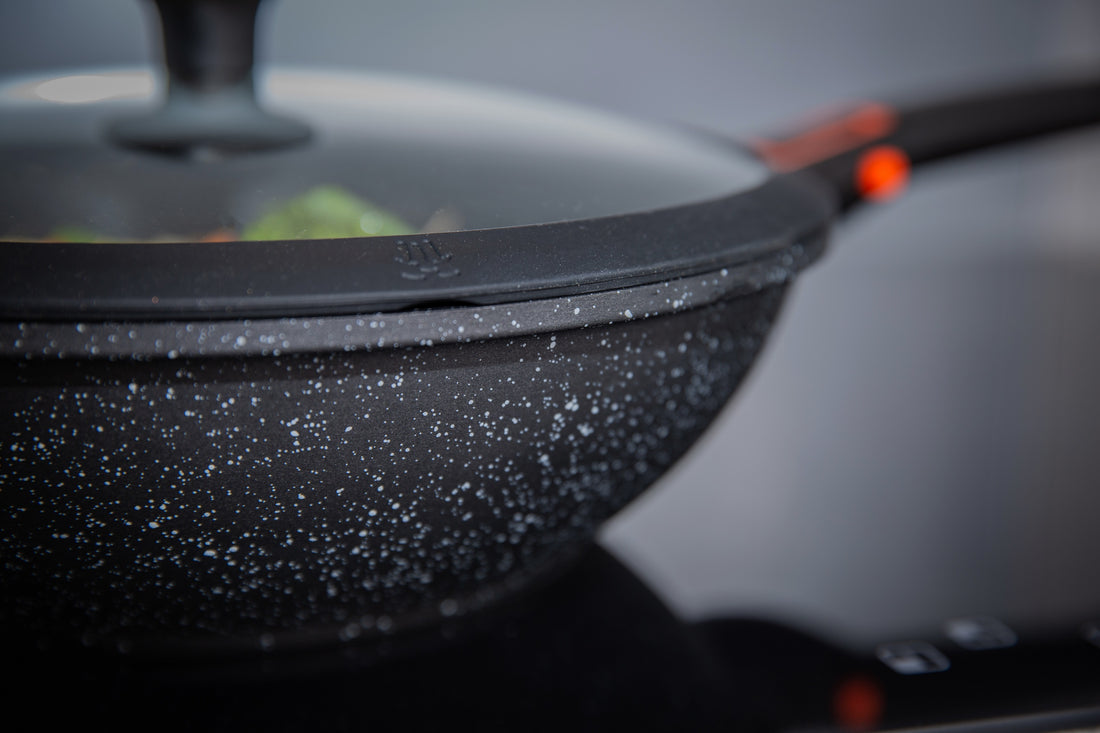Embracing the Versatility of the Wok
The wok, with its distinctive shape and storied history, is more than just a piece of cookware; it is a testament to culinary ingenuity and versatility. Originating in China over 2,000 years ago, the wok has transcended its cultural roots to become a beloved kitchen staple worldwide. This blog post will delve into the myriad uses of a wok, exploring its unique design and the diverse cooking techniques it facilitates. Whether you are a seasoned chef or a home cook, understanding how to maximise the potential of a wok can revolutionise your cooking experience.
The Anatomy of a Wok
Before diving into the various cooking methods, it’s essential to understand what makes a wok unique. Traditional woks are round-bottomed, although flat-bottomed woks have become popular, especially for use on Western stovetops. Made from materials such as carbon steel, cast iron, and stainless steel, woks come in various sizes, typically ranging from 28 to 36 centimetres in diameter for home use.
The round bottom and sloping sides of a wok are its defining features. These characteristics enable efficient heat distribution and allow for high-heat cooking. The high sides also make it easy to toss and stir ingredients without spilling, which is crucial for many wok-based cooking techniques.
Stir-Frying: The Quintessential Wok Technique
Stir-frying is perhaps the most well-known cooking method associated with the wok. This technique involves cooking small, uniformly cut ingredients over high heat while continuously stirring. The wok’s shape allows for even heat distribution, which is crucial for achieving that perfect sear and retaining the ingredients' nutritional value and texture.
Steps for Perfect Stir-Frying:
- Preparation: Have all ingredients prepped and ready before heating the wok. This includes chopping vegetables, slicing meat, and preparing any sauces.
- Heating the Wok: Heat the wok over high heat until it starts to smoke slightly. This ensures the wok is hot enough to sear the ingredients properly.
- Oil: Add a small amount of oil with a high smoke point, such as peanut or vegetable oil, and swirl to coat the wok’s surface.
- Cooking: Add the ingredients in stages, starting with aromatics like garlic and ginger, followed by meat or protein, and finally vegetables. Keep the ingredients moving to prevent burning and ensure even cooking.
- Sauce: Add any sauce towards the end of cooking, tossing everything to coat evenly before serving.
Stir-frying is ideal for creating quick, healthy meals with vibrant flavours and textures. Dishes like beef and broccoli, kung pao chicken, and vegetable stir-fry exemplify the best of this technique.
Deep-Frying: Achieving Crisp Perfection
While not commonly associated with woks, deep-frying in a wok is highly effective. The wok’s deep, rounded shape requires less oil than a traditional deep fryer and provides ample space to fry foods without overcrowding.
Tips for Deep-Frying in a Wok:
- Oil Temperature: Use a thermometer to maintain the oil at the correct temperature, usually between 175°C to 190°C. Too low, and the food absorbs oil and becomes greasy; too high, and it can burn.
- Small Batches: Fry in small batches to maintain the oil temperature and achieve even cooking.
- Drain: Use a wire rack or paper towels to drain excess oil after frying.
Popular deep-fried dishes include spring rolls, tempura vegetables, and crispy chicken. The result is food with a golden, crispy exterior and tender interior, achieved with minimal oil usage.
Steaming: A Healthy Alternative
The wok is also an excellent vessel for steaming, which is one of the healthiest cooking methods as it retains nutrients and requires no added fats. By using a bamboo steamer basket that fits snugly within the wok, you can steam everything from dumplings to fish fillets.
Steps for Steaming in a Wok:
- Water Level: Add enough water to the wok to reach just below the steamer basket, usually about 5 centimetres.
- Boiling: Bring the water to a boil before placing the steamer basket with the food in the wok.
- Cover: Use a lid or aluminium foil to cover the steamer, trapping the steam and cooking the food evenly.
Steaming in a wok is particularly effective for preparing delicate foods like seafood, vegetables, and dim sum.
Boiling and Poaching: Gentle Cooking Techniques
Although less conventional, the wok's shape makes it suitable for boiling and poaching. The wide surface area allows for even heat distribution, and the depth is perfect for cooking noodles, dumplings, and soups.
Boiling and Poaching Tips:
- Even Heating: Ensure the heat is evenly distributed by bringing the liquid to a gentle boil or simmer.
- Submersion: Keep the ingredients fully submerged for consistent cooking.
Dishes like ramen, pho, and poached chicken can be effortlessly prepared using the wok’s boiling and poaching capabilities.
Smoking: Infusing Rich Flavours
Smoking in a wok is a technique that can impart deep, rich flavours to meats, fish, and even vegetables. It involves using a wok, a metal rack, and a cover to create a smoking chamber.
Steps for Smoking in a Wok:
- Foil Lining: Line the bottom of the wok with aluminium foil and add wood chips, tea leaves, or rice for smoking.
- Rack Placement: Place a metal rack over the smoking materials.
- Cover and Smoke: Place the food on the rack, cover the wok, and heat until smoke begins to form. Reduce the heat and allow the food to smoke for the desired time.
Smoking with a wok can produce restaurant-quality smoked dishes like tea-smoked duck and smoked tofu.
Roasting and Toasting: Enhancing Aromas and Flavours
The wok's high heat capacity makes it suitable for dry roasting spices and nuts, intensifying their flavours and aromas. Additionally, it can be used for toasting grains and seeds, providing a robust flavour profile to various dishes.
Dry Roasting Tips:
- Low to Medium Heat: Use low to medium heat to avoid burning.
- Constant Movement: Stir or toss the ingredients constantly to ensure even roasting.
Roasting cumin, coriander seeds, or toasting sesame seeds and pine nuts in a wok can elevate your culinary creations.
Baking: A Lesser-Known Use
While not traditionally used for baking, a wok can function similarly to an oven when covered and used over low heat. This method is particularly useful for baking flatbreads and cakes when an oven is unavailable.
Baking in a Wok:
- Low Heat: Preheat the wok over low heat.
- Covering: Place the batter or dough in a suitable pan that fits inside the wok, cover with a lid, and allow it to bake.
This unconventional method can yield surprisingly good results, making it a versatile option in situations where an oven is not accessible.
Care and Maintenance of Your Wok
To ensure longevity and optimal performance, proper care and maintenance of your wok are crucial. Here are some tips:
- Seasoning: (If required) Carbon steel and cast iron woks require seasoning to develop a non-stick surface and prevent rust. Coat the wok with a thin layer of oil and heat it until it smokes, then wipe it clean. Repeat this process several times.
- Cleaning: Avoid using soap on seasoned woks, as it can strip the seasoning. Instead, use hot water and a soft brush or sponge. For stubborn residues, use a paste of coarse salt and water to scrub gently.
- Storage: Store the wok in a dry place to prevent rust. If the wok develops rust, it can be scrubbed off and re-seasoned.
Properly maintaining your wok will ensure it remains a reliable kitchen companion for years to come.
The Wok as a Culinary Powerhouse
The wok is a truly remarkable piece of cookware, offering unparalleled versatility and efficiency in the kitchen. Its ability to handle a wide range of cooking techniques – from stir-frying and deep-frying to steaming, boiling, poaching, smoking, roasting, and even baking – makes it an indispensable tool for both professional chefs and home cooks.
By mastering the use of a wok, you can unlock new culinary possibilities and elevate your cooking to new heights. The key lies in understanding the wok's unique properties, properly maintaining it, and experimenting with the diverse techniques it supports. Whether you're preparing a quick stir-fry for a weeknight dinner or embarking on a more elaborate culinary project, the wok is your trusted ally in creating delicious, nutritious, and visually stunning dishes.
So, embrace the wok, explore its potential, and let it transform your cooking experience.
The Pep Wok is a fuss free wok that doesn't need seasoning. Check it our HERE...Happy cooking!

